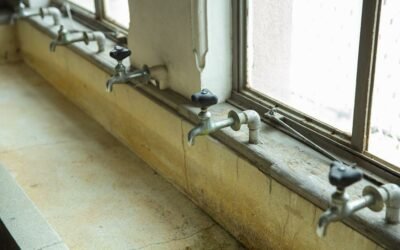Are you aware of the hidden dangers lurking in your air purifier?
Discover how bacteria can accumulate in these devices and the potential health risks they pose.
Learn essential strategies to prevent bacterial growth and ensure clean, healthy air in your home.
With proper maintenance, you can safeguard against the harmful effects of air purifier bacteria.
Take control of your indoor air quality and protect your well-being.
Key Takeaways
- Air purifiers can become breeding grounds for harmful bacteria
- Bacteria in air purifiers can cause respiratory issues, allergies, and infections
- Regular cleaning and disinfection of filters, surfaces, and water reservoirs is necessary to prevent bacterial growth
- Choosing air purifiers with high-efficiency filters and advanced filtration technologies can help reduce the risk of bacteria accumulation
The Hidden Dangers of Air Purifier Bacteria
You should be aware of the hidden dangers posed by air purifier bacteria. While air purifiers are commonly used to improve indoor air quality, they can inadvertently become breeding grounds for harmful bacteria. These bacteria can pose serious health risks to you and your family.
Air purifiers work by trapping airborne particles and pollutants in their filters. However, if the filters aren't properly maintained, they can become a breeding ground for bacteria. The warm and humid environment inside the filter provides the perfect conditions for bacteria to multiply and thrive.
Once bacteria have colonized the filter, they can be released back into the air when the purifier is turned on. This can lead to respiratory issues, allergies, and even infections. The bacteria can also spread to other surfaces in your home, increasing the risk of contamination.
To mitigate the risks associated with air purifier bacteria, it's important to regularly clean and replace the filters. Additionally, choosing an air purifier with a HEPA filter can help to minimize the growth of bacteria.
Understanding How Bacteria Accumulate in Air Purifiers
As bacteria colonize the filters, it's important to understand how they accumulate in air purifiers, creating potential health risks for users. Bacteria can enter air purifiers through various sources, such as outdoor air, human activities, or existing contamination within the indoor environment. Once inside the purifier, bacteria can adhere to the surfaces of the filters due to their inherent stickiness and the presence of organic matter that serves as a nutrient source.
The accumulation of bacteria in air purifiers is influenced by factors such as airflow patterns, humidity levels, and the design of the purifier itself. Airflow patterns play a crucial role in the accumulation of bacteria. As air is drawn into the purifier, it passes through the filters, which trap airborne particles. Bacteria that are present in the air can get trapped in the filter fibers, where they start to multiply and form colonies.
The accumulation of bacteria is further facilitated by the relative humidity within the purifier. High humidity levels provide an ideal environment for bacterial growth, allowing them to thrive and reproduce rapidly. The design of the air purifier can also impact bacterial accumulation. Some purifiers have complex filter structures with crevices and folds, which can provide additional surface area for bacteria to colonize. Additionally, the presence of stagnant areas within the purifier can promote bacterial growth by reducing airflow and allowing bacteria to settle and accumulate.
Understanding how bacteria accumulate in air purifiers is crucial for maintaining the effectiveness of these devices and ensuring the health and safety of users. Regular filter replacement and proper maintenance can help prevent excessive bacterial accumulation and minimize the associated health risks.
Potential Health Risks Associated With Air Purifier Bacteria
The accumulation of bacteria in air purifiers can pose potential health risks, particularly due to the release of airborne bacteria back into the indoor environment. While air purifiers are designed to improve indoor air quality by removing pollutants, they can inadvertently become breeding grounds for bacteria if not properly maintained. Bacteria can colonize the filters, surfaces, and water reservoirs of air purifiers, leading to the formation of biofilms and the release of bacteria into the air.
When bacteria are released back into the indoor environment, they can potentially cause respiratory infections, allergies, and other adverse health effects. This is especially concerning for individuals with compromised immune systems, such as the elderly, young children, and those with chronic illnesses. The bacteria released by air purifiers can include harmful pathogens such as Staphylococcus aureus, Pseudomonas aeruginosa, and Legionella pneumophila, which have been associated with respiratory infections, pneumonia, and even Legionnaires' disease.
To mitigate the potential health risks associated with air purifier bacteria, regular maintenance and proper cleaning are essential. This includes changing filters according to manufacturer's recommendations, cleaning and disinfecting surfaces, and regularly cleaning and sterilizing water reservoirs. Additionally, it's important to choose air purifiers with high-efficiency filters and advanced filtration technologies that can effectively capture and remove bacteria from the air.
Strategies to Prevent Bacterial Growth in Air Purifiers
To prevent bacterial growth in air purifiers, it's important to regularly clean and disinfect the filters, surfaces, and water reservoirs. Bacteria can thrive in these areas if left unattended, compromising the effectiveness of the air purifier and potentially leading to the release of harmful microorganisms into the air.
Cleaning the filters should be done according to the manufacturer's instructions, as different types of filters require different cleaning methods. This typically involves removing the filters and gently washing them with soap and water or using a vacuum cleaner to remove dust and debris. Disinfecting the filters can be done by soaking them in a solution of water and bleach or using a disinfectant spray.
Surfaces of the air purifier, such as the outer casing, control panel, and vents, should also be wiped down regularly with a disinfectant solution to remove any bacteria that may have accumulated.
Additionally, water reservoirs, if present, should be emptied, cleaned, and refilled regularly to prevent bacterial growth.
Ensuring Clean and Healthy Air With Proper Maintenance
Regular maintenance is key to achieving clean and healthy air with your air purifier. By following a few simple steps, you can ensure that your air purifier continues to function optimally and effectively remove pollutants from your indoor environment.
Firstly, it's important to regularly clean or replace the filters in your air purifier. Filters are designed to capture dust, pollen, pet dander, and other airborne particles. Over time, these particles accumulate and can hinder the performance of your air purifier. By cleaning or replacing the filters according to the manufacturer's instructions, you can maintain the efficiency of your device and ensure that it continues to remove pollutants effectively.
In addition to filter maintenance, it's crucial to clean the exterior of your air purifier regularly. Dust, dirt, and other debris can accumulate on the surface of the device, which can impact its performance. Wiping down the exterior with a damp cloth or using a soft brush to remove any buildup will help to maintain the cleanliness of your air purifier.
Lastly, it's recommended to keep your air purifier in a well-ventilated area. Proper ventilation allows for the circulation of fresh air and prevents the buildup of stagnant air around the device, which can promote the growth of bacteria and mold.
Conclusion
In conclusion, the presence of bacteria in air purifiers poses hidden dangers to our health. It's crucial to understand how bacteria accumulate in these devices and the potential health risks they can cause.
By implementing strategies to prevent bacterial growth and ensuring proper maintenance, we can ensure clean and healthy air in our surroundings. This scientific approach is essential for maintaining a safe indoor environment and protecting our well-being.






0 Comments